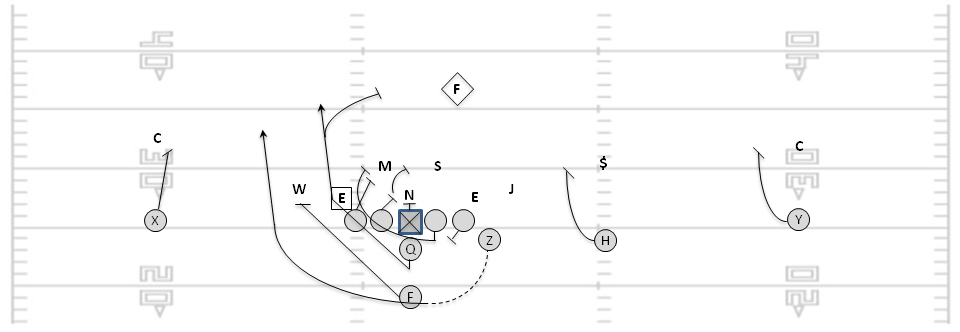Run and shoot shovel pass away from trips
At the end of his description of the quarterback's responsibilities in the shovel play, coach Black throws in this tidbit: "After the pitch he should continue downfield to be in position to receive a pitchout from the receiver he tossed the ball to."
Very interesting. In any option play, the quarterback occupies a defender who would otherwise have to be blocked or faked, reducing the minimum number of unoccupied defenders to one (the counterpart of the ballcarrier) from two (the counterparts of the ballcarrier and the QB). But if the ballcarrier (here, the slot receiver) can also occupy a defender with an option, then the number of free defenders is reduced to zero. Put another way, a shovel pass give-and-go creates a triple option (keep, pitch, or pitch and pitch back) with only two runners, meaning two defenders can be left unblocked, the nine remaining defenders can be blocked or otherwise occupied by nine offensive players, and nobody will be left to tackle the ball. Touchdown, right? And furthermore, revolutionary offensive concept, right?
Maybe not. Note that coach Black doesn't actually leave two defenders unblocked. One truism about defending the triple option is that when the two reads twist, the pitch key is left free to hit the dive back:
A good triple option team with an experienced quarterback will read the stack twist and pitch the ball early to the third runner, but that's not an option when there are only two backs in the play. So the second key has to be blocked, making the second pitch just a bonus - an extra twist that can create a breakaway run if it happens, but not a reliable component of a true triple option.
Unless the two keys are too far apart to twist. If the pitch key were a deep safety instead of a flat defender, then the give-and-go triple option just might work. A speed option or inverted veer would make a better framework for it than a shovel pass, though, since these would keep the option decision-making with the quarterback rather than a slot receiver who just caught a pass while looking backward.
The quarterback in the two man triple should occupy the second defender regardless of the initial read, either by optioning the safety if he still has the ball or by blocking him if he initially pitched it.
Outside of desperate, final-play situations, we rarely see a designed downfield lateral in a game. Unlike in a game like rugby, ball possession in football is usually considered too valuable to risk with a lateral. However, any discussion of risk has to consider benefits and consequences along with probabilities. As the score deficit grows and the time remaining in the game shrinks, a team's risk tolerance should increase correspondingly:
Basic three-region relative risk profile as a function of score differential and time remaining.
At some combination of score to make up and time remaining to do it, a designed downfield pitch becomes a rational tactic. The fact that we virtually never see it suggests two things: (1) that coaches are overly risk-averse, something that many if not most fans now accept as obvious, and/or (2) that the relatively narrow game circumstances in which a downfield lateral play would be useful ensures that for most teams the play's benefits do not justify its cost in terms of practice time.
Nevertheless, it seems that given all the teams that play football, some must exist with the combination of relatively high benefit (offensive need) and relatively low practice-time cost (already run the option) that would make it worthwhile to add an extra pitch option to one of their plays. To pull it off, the pitchman will have to work hard to maintain a pitch relationship and the quarterback will have to stay composed and deliver an accurate pitch while both are sprinting through the defensive secondary. The other players blocking downfield will have to sustain great blocks, and the pitchman will have to let the quarterback know that he is available for the pitch, or else the quarterback might pitch it right to a defender who has shed his block and is pursuing from outside in. But for teams that need a big play, all of these risks may be outweighed by the benefit of a long scoring run.






This is an awesome post. I think it is very useful for playing football. This sharing concept is a good way to enhance the knowledge pool about football. Thank you very much for this post. Waiting for the next.
ReplyDeleteclick goals
Wow! This is the perfect blog I am looking this type of blog its awesome blog here , share great information about this topic. This informative blog helps many readers with their decision-making regarding the situation. Great articles and will look forward for more!
ReplyDeletevegus168